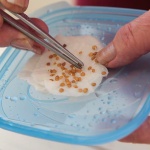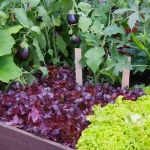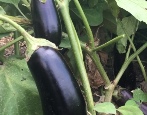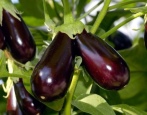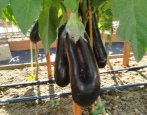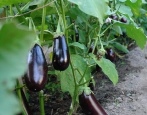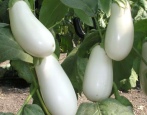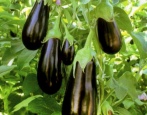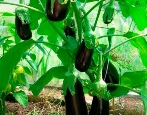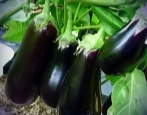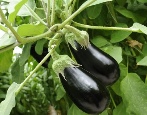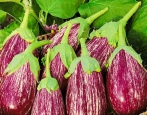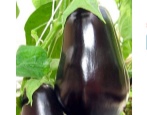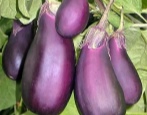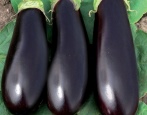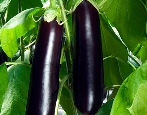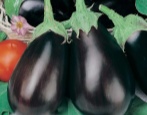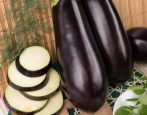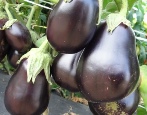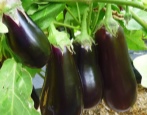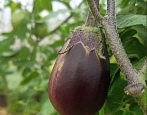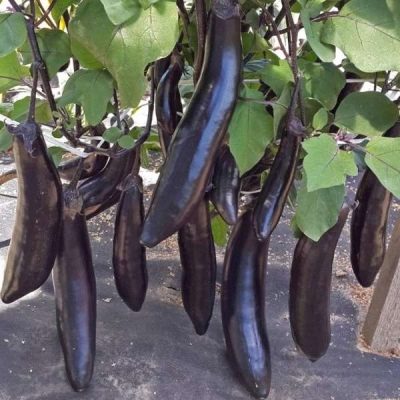
- Growth type: medium-sized
- Bush height, cm: 100
- Fruit size: large
- Fruit shape: cylindrical
- Yield: high yielding
- Fruit color: dark purple
- Keeping quality: excellent
- Marketability: excellent
- Ripening terms: early
- Pulp (consistency): not loose
When choosing an eggplant variety for growing, many gardeners prefer hybrid forms, since they adapt to the climate as quickly as possible, practically do not get sick, and also give good yields. A striking example of this will be the early ripe hybrid King of the Market, created by domestic breeders.
Description of the variety
The king of the market is a hybrid of the first generation, bred by Russian scientists of the agricultural company "NK Russkiy Ogorod" in 2009. The parental forms of eggplant are Prince and Gardener's Dream. Despite the fact that the hybrid is not included in the State Register, its popularity is growing. Today the vegetable is grown in different climatic zones of Russia. Eggplant is cultivated both in greenhouses and in garden beds.
Characteristics of the appearance of plants and fruits
Vegetable culture The king of the market is a medium-sized plant that grows in height up to 90-100 cm in greenhouse conditions, and up to 50-60 cm in the beds. The eggplant bush is characterized by semi-sprawling branches, moderate thickening with dark green leaves with purple veins, a powerful central stem with pronounced hairiness, but without thorns, as well as a developed surface type rhizome. During flowering, medium-sized bright purple flowers appear on the bushes. On average, up to 10 copies of the presentation ripen on one eggplant bush.
The hybrid belongs to large-fruited species. The average weight of a vegetable is 200-250 grams, sometimes larger specimens ripen - up to 450-500 g. The length of the fruits is about 18-22 cm, and the diameter is 5-6 cm. The shape of the eggplant is neat, cylindrical or elongated, with a pointed apex. Sometimes, in a cool summer, the shape is slightly deformed, so the vegetable takes on a curved appearance. The surface of the fruit is smooth, without depressions and waviness, with a pronounced gloss.
The peel is thin, but strong, which ensures good transportability and long shelf life of vegetables. At a temperature of + 6-8 degrees, neatly cut fruits can be stored for about 2 months.
Purpose and taste
Eggplant has a classic taste, without bitterness and off-flavor. The snow-white pulp has a delicate, moderately dense and oily consistency without friability and wateriness. Light mushroom notes are felt in the taste. There are practically no seeds in the eggplant pulp.
Eggplants can be fried, grilled, rolled up for the winter. In addition, the King of the Market is ideal for stuffing and baking.
Ripening terms
The king of the market is an early maturing hybrid. From mass germination to full ripening of the first vegetables on the bushes, 100-110 days pass. From the moment the seedlings are transplanted to a permanent place until the eggplant ripens, 60-64 days pass. Vegetables are ripened at different times, so the fruiting period is extended. It is recommended to take them off every 4-5 days. Harvesting occurs in July-September.
Yield
The king of the market always pleases with good harvests. Usually up to 3 kg of fleshy eggplants are collected from one bush. As a rule, under favorable conditions and proper care, about 10 kg of fruit can be harvested from 1 m2 of plantings.
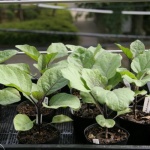
To get a tasty and bountiful eggplant crop, you must first grow strong and healthy seedlings. This culture is considered very capricious, therefore, you need to take care of seedlings when growing at home as correctly and carefully as possible.
Landing scheme
When cultivating eggplant bushes, do not forget about planting density and keeping the distance between plantings. There are no more than 4-5 bushes per 1 m2. The vegetable is planted according to the standard scheme - 40x60 cm.
Growing and caring
Vegetable crops are planted using the seedling method. Suitable for planting seedlings at the age of 60 days. Planting in a greenhouse or garden is carried out in early June. The best place for planting will be an area where carrots, beets and greens previously grew.
Agrotechnics for eggplant are standard: weekly irrigation with settled water exclusively at the root, top dressing three times per season (preferably mineral complexes), fluffing and weeding of the soil every 10 days, mulching of row spacings, frequent removal of lateral shoots and foliage, garter bushes, prevention of diseases and pest infestations.
In addition, you need to remember about airing greenhouses, as well as creating a bedding layer on the ground so that vegetables, in contact with the ground, do not rot.
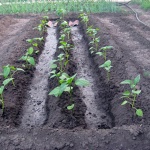
Planting eggplant is one of the most important stages in growing. When choosing a place for eggplants in your area, it is important to remember that this culture should be in warm soil, constantly illuminated by the sun. The plant is also very fond of spacious, open spaces, since its roots can grow over sufficient areas.


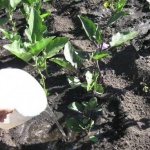
Soil requirements
Eggplant The king of the market is picky about the composition of the soil, so it is prepared in advance. The soil should be loose, light, nutritious, moist, breathable and neutral in acidity.
Required climatic conditions
Hybrid The King of the Market is quite stress-resistant. The vegetable is resistant to temperature jumps, short cold snaps and short shading. Eggplant is planted in sunny areas, where there is mandatory protection from drafts. The best place is considered to be a small hill.
Disease and pest resistance
The king of the market is the owner of high immunity, therefore it is resistant to many diseases.
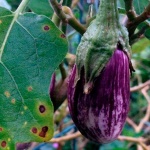
Eggplant is one of the most demanding crops. For its successful cultivation, it is necessary to create optimal conditions, as well as to carry out prevention and fight against diseases and pests. Eggplant often infects both fungal and viral diseases. If treatment is not started on time, you can completely lose the crop.
